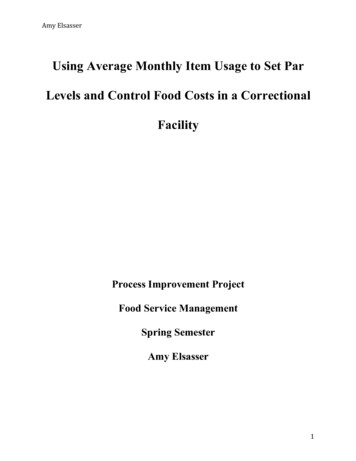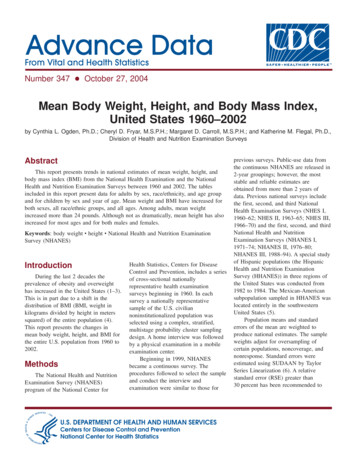
Transcription
Using PMU Datato Increase Situational AwarenessFinal Project ReportPower Systems Engineering Research CenterEmpowering Minds to Engineerthe Future Electric Energy System
Using PMU Data to IncreaseSituational AwarenessFinal Project ReportProject TeamTom Overbye, Project LeaderPete SauerUniversity of Illinois at Urbana-ChampaignChris DeMarcoBernie LesieutreUniversity of Wisconsin-MadisonMani VenkatasubramanianWashington State UniversityPSERC Publication 10-16September 2010
Information about this projectFor information about this project contact:Thomas J. OverbyeFox Family Professor of Electrical and Computer EngineeringUniversity of Illinois at Urbana-Champaign1406 W. Green StUrbana, IL 61801Tel: 217-333-4463Fax: 217-333-1162Email: Overbye@illinois.eduPower Systems Engineering Research CenterThe Power Systems Engineering Research Center (PSERC) is a multi-university Centerconducting research on challenges facing the electric power industry and educating thenext generation of power engineers. More information about PSERC can be found at theCenter’s website: http://www.PSERC.org.For additional information, contact:Power Systems Engineering Research CenterArizona State University577 Engineering Research CenterTempe, Arizona 85287-5706Phone: 480-965-1643Fax: 480-965-0745Notice Concerning Copyright MaterialPSERC members are given permission to copy without fee all or part of this publicationfor internal use if appropriate attribution is given to this document as the source material.This report is available for downloading from the PSERC website. 2010 University of Illinois at Urbana-Champaign. All rights reserved.
AcknowledgementsThis is the final report for the Power Systems Engineering Research Center (PSERC)research project titled “Using PMU Data to Increase Situational Awareness.” Weexpress our appreciation for the support provided by PSERC’s industrial members and bythe National Science Foundation under grants NSF IIP-0968983, 0968833 and 0968818received under the Industry / University Cooperative Research Center program.The authors would also like to convey special acknowledgement to the PSERC IABmember companies who provided direct assistance with this project including BPA,Entergy, EPRI, Exelon, MISO, ISO New England, PowerWorld, PJM, Quanta, and TVA.
Executive SummaryWith the large-scale deployment of PMUs in the U.S. and worldwide, a recurring themehas been the question of how to best extract useful “information” or “knowledge” fromthe very voluminous data that PMUs provide. While the direct control center display ofPMU-based data is certainly important, particularly bus voltage angle values, this projectfocused on techniques the go beyond direct display of the raw PMU data. That is, theproject focused on how information could be extracted from the PMU data, and then howthis information could be used to improve power system situational awareness. Fivedifferent aspects of the problem are considered in Chapters 2 through 6.Chapter 2 considers how much information could be gleaned from the PMU datawith an approach that makes minimal use of other a priori information about thesystem status and model parameters. It is based on a data analysis tool that has beenwidely utilized for compression and feature extraction in other industries: the SingularValue Decomposition (SVD). The SVD method for PMU data processing views thephysical power system as a power flow solver – taking time varying loads/injections asinputs, and producing PMU-measured angles and voltage magnitudes as outputs. Byobserving a time window of PMU measurements over an interval, forming a matrix ofdata, and computing the singular value decomposition of this matrix as this window“slides” forward in time, the Chapter 2 algorithm characterizes important aspects of thesystem’s input-to-output behavior. When the system is highly stressed, one sees outputsvary much more dramatically in response to time variation of the inputs. This efficientlycomputes information closely related to the Power Flow Jacobian matrix conditioning,with none of the state estimator and network data required to compute the PF Jacobianmatrix itself – the algorithm uses PMU measurements only. Conditioning of the PowerFlow Jacobian is a general indicator of robustness of a system operating point; morespecifically, the smallest singular value of the power flow Jacobian (i.e., as it approacheszero) has long been utilized as a first indicator of vulnerability of a system to voltagecollapse. Hence, one of the outputs of SVD-based PMU processing algorithm serves as areal-time indicator of system stress, tracking a well-established voltage stabilityperformance metric without the need for detailed network parameter values or stateestimator results.Chapter 3 presents an algorithm on how PMU data can be used to enhance existingpower flow algorithms to improve situational awareness. The motivation for thisapplication arises because in a variety of situations SE results may not be available. Forexample, smaller utility control systems may not have an SE, the SE may have failed toconverge during rapidly changing system conditions, there may be a need to combine SEresults with a larger system model, or people involved in nonoperational aspects of thepower grid, such as marketers and power system planners, may not have access to SEresults. But often a power flow case is available that at least approximates (to somedegree) the current operating condition. The Chapter 3 algorithm shows how existinglinear programming (LP) based optimal power flow algorithms (OPF) can be used tochange a power flow operating point to better match the bus voltage angles coming fromthe PMUs. The algorithm is demonstrated using a three bus case and a 13,000 bus case.ii
Chapter 4 presents the visualization of PMU-derived information associated withpower system electromechanical oscillations using the Washington State UniversityOscillation Monitoring System (OMS). The inputs to the OMS are selected PMU busvoltage measurements. When a disturbance is detected the OMS uses a real-time Pronyanalysis with a moving time-window to determine the oscillation frequency and dampingratio. Results are visualized with a user-friendly, web-page interface.Two example visualizations are presented. In the first, the Damping Monitor display,there are three major areas. Left top is a frequency vs. damping ratio point chart, whichshows all the modes in the frequency domain, and their damping ration on y-axis. Theright top corner shows the time and a brief summary, which includes the status of eachmode. The bottom of the display is the mode shape area, which shows mode shapes of upto 4 modes, in a radial fashion. In the second, the Event Monitor display, there are twoareas. The top area shows the mode frequency and the damping ratio with a dial likechart. The bottom part shows the mode shape, as in the Damping Monitor display.Chapter 5 considers how PMU data can improve situational awareness byimproving the load models used for power system analysis platforms. Themathematical models for loads used in most security (operational reliability) analysisrange in detail from simple impedances to generic dynamic models and full-blowninduction motor models. These load models typically have various parameters thatdescribe their behavior and power consumption. In hour and day-ahead analysis, theloads are essentially based on power forecasts. Two things about these load models areimportant in the analysis. The first thing is the model structure (static, dynamic etc.); thesecond is the model parameter values.Since PMUs provide virtually real-time values of voltages and currents, they have thepotential to be useful in producing virtually real-time load models for security(operational reliability) analysis. If the PMU data come from locations that could beconsidered “load buses”, then analysis of these measurements could provide informationon the structure of the load model and the parameters of the model. This portion of theproject developed a process to perform this analysis.This process was then evaluated with simulated phasor data using a 3-machine, 9-bussystem, and a 9-machine, 30-bus system. For each system, several cases with differentload models were simulated using the automatic identification procedure. The voltagevariation was detected to start the estimation process. The load type was determined byinspecting the P-V relation and by using the self-augmented model. LMA was used toestimate model parameters. Finally, the estimation results were validated by using thedata after that until another voltage variation was detected. The results from both testcases using simulated phasor data indicate that the method could become a valuable toolfor model identification in real time.The application of PMU data to improve reactive power monitoring and control isconsidered in Chapter 6. The ability to supply reactive power when it is needed canhelp a system to obtain a new stable operating point instead of becoming unstable.Generally, such reactive power control occurs only at the transmission system level.Chapter 6 develops a framework to allow control of distributed reactive-power capabledevices located near the end-user. In particular, inverters such as those connected to PViii
panels and pluggable-hybrid electric vehicles (PHEVs) can be used to operate at aleading power factor and thus supply reactive power.The communication and control for these reactive power resources can be coordinated ina hierarchical way. First, the voltage problem must be detected. Then, the appropriateresponse action needed to correct the voltage problem is computed. The solution at thisstage gives locations and amounts of reactive power needed to correct the problem.Action requests are formulated and sent to an agent, which may be located in a relay on afeeder. This feeder agent may be upstream of several other relays and load controllers.The requests propagate downward. At each level, a set of response actions needed tofulfill the request are determined and sent to the next level in the hierarchy. Results aredemonstrated using the IEEE 24-bus reliability test system.Future Research StepsWith the rapid growth in PMU installations across many power systems it is clear thatPMUs will play a role of increasing importance in power system operations. While thisproject has presented solid research for moving forward, there is certainly more work tobe done. The SVD work from Chapter 2 needs to be further tested and validated; alsoapplications to other PMU-based measurements should be considered. While the Chapter3 work of incorporating PMU-measurements into the power flow could also benefit fromadditional testing, it is at the stage in which commercial implementation should beconsidered. The Chapter 4 OMS is currently undergoing utility testing; the associatedvisualizations could be enhanced based upon the results of this testing. The Chapter 5load modeling work should having additional testing with actual PMU data; it could alsobe extended to consider more dynamic load models, such as induction machines andother devices such as synchronous generators. Last, the Chapter 6 use of PMUs forimproved reactive power modeling as advanced to the point in which actual prototypeinstallations can be considered.iv
Table of Contents1. Introduction . 11.1 Background and Problem Overview . 11.2 Report Organization . 32. A Singular Value Decomposition Approach to PMU Data . 42.1 Background. 42.2 Singular Value Decomposition (SVD) Overview . 62.3 Singular Value Decomposition in Data Compression . 72.4 Interpreting PMU Data in the SVD Perspective. 82.5 Caveats and Practical Issues . 112.6 Computational Experiments in Synthetically Generated Data . 122.7 SVD Tests on Bonneville Power Historic PMU Data Sets . 152.8 Conclusions . 163. PMU Enhanced Power Flow Solutions. 183.1 Background. 183.2 The Global Properties of Bus Phase Angles. 183.3 PMU Morphed Power Flow Solutions . 224. Visualization of Oscillation Monitoring System Results. 284.1 Background. 284.2 Visualization of OMS Results . 295. Application of PMU Values for Improved Load Models . 335.1 Background. 335.2 Overview of the Problem. 335.3 Load Models . 345.4 Load Identification . 375.4.1 Voltage variation detection . 385.4.2 Load structure selection . 395.4.3 Parameter estimation . 395.4.4 Load Model Validation . 395.5 Simulation Results . 406. Distributed Voltage Support on the Smart-Grid . 486.1 Background. 486.2 Detect and Respond Framework . 486.3 Distributed Reactive Power . 517. Summary and Directions for Future Work . 55Project Publications . 56References . 57v
List of FiguresFigure 1.1 WECC Display of voltage phase angles as a color contour and voltagemagnitudes using thermometers . 2Figure 1.2 BPA bus phase angle display from 2004. 2Figure 1.3 Bus voltage phase angle comparison dial . 3Figure 2.1 Geometric illustration of SVD of matrix J . 7Figure 2.2 Geometric view of the incremental approximation to power flow mapping. 9Figure 2.3 Geometric view of power flow mapping – lightly stressed case . 10Figure 2.4 Geometric view of power flow mapping – highly stressed case . 10Figure 2.5 IEEE 14 bus example – idealized limit of PMU at every bus . 13Figure 2.6 Figure: IEEE 118 bus case A – PMU penetration 11 out of 118 buses (PMUplacement for case A: buses 9,12, 26, 28, 30, 32, 33, 78, 95, 101, 106) . 13Figure 2.7 IEEE 118 bus case B – PMU penetration 11 out of 118 buses (PMU placementcase B: buses 9,14, 21, 29, 41, 55, 59, 64, 72, 84, 102). 14Figure 2.8 SVD-based PMU measure for BPA test data, 8-hour periods for 6 days, codedas S08, S09, S10, S22, S23, S24; horizontal axis hours, vertical axis maximum SVD onwindowed measurements . 15Figure 3.1 Dependence of Wempleton 345 kV bus angle (in Northern Illinois) on powerinjections throughout the Eastern Interconnect. 20Figure 3.2 Dependence of phase angle difference between the Wempleton and Burnham345 kV bus angles (in Northern Illinois) on power injections throughout the EasternInterconnect. 21Figure 3.3 Zoomed view of Wempleton to Burnham phase angle differencesensitivities . 21Figure 3.4 Piecewise Linear Cost Function . 24Figure 3.5 Three bus system . 24Figure 3.6 13,000 bus Midwest system angle contour before transaction . 25Figure 3.7 13,000 bus Midwest system angle contour, with 2000 MW transactionto Slack Area . 26Figure 3.8 13,000 bus Midwest system angle contour, original case morphed using fourangle measurements . 27Figure 4.1: Flowchart of OMS . 28Figure 4.2 Illustration of OMS results from the two engines . 29Figure 4.3 Data flow of OMS Project . 30Figure 4.4 Snapshot example of a Damping Monitor webpage. 31vi
Figure 4.5 Snapshot of an Event Monitor webpage . 32Figure 5.1 Load modeling procedure flow chart . 38Figure 5.2 WSCC 3-machine, 9-bus systems . 41Figure 5.3 Relative parameter error for WSCC system with ZIP load model . 43Figure 5.4 Relative parameter error for WSCC system with exponential load model. . 44Figure 5.5 GNLD and nonparametric model simulated results compared withmeasurement. . 45Figure 5.6 30-bus, 9-machine system . 46Figure 6.1 Hierarchical structure of reactive support system . 49Figure 6.2 Flowchart of Detection and Response Framework . 50Figure 6.3. IEEE 24-bus RTS . 51Figure 6.4. RTS voltage profiles . 52vii
List of TablesTable 5.1 ZIP Load Model Parameter Estimation . 42Table 5.2 Exponential Load Model Parameter Estimation . 43Table 5.3 GNLD Model Parameter Estimation . 44Table 5.4 GNLD Model Parameter Estimation . 45Table 5.5 Exponential Load Model Parameter Estimation . 46Table 5.6 ZIP Load Model Parameter Estimation . 47Table 6.1. RTS Voltage Improvement . 52Table 6.2 Reactive Support Groups for the IEEE-24 Bus RTS . 53viii
1. Introduction1.1 Background and Problem OverviewAccording to the August 2003 blackout report [37], one critical need for the powerindustry is an increase in its situational awareness. Over the last two decades much workhas been done in determining the best ways to represent traditional SCADA and EMSinformation to operators to increase their understanding of grid conditions, with much ofthis work now finding its way into electric utility application. As this work hasprogressed, new devices have continuously been added to the power grid. One of themost interesting new devices deployed on the power system, the phasor measurementunit (PMU) [1], is just now beginning to see wide scale deployment in electric utilitycontrol center supervisory applications.From a situational awareness perspective there are three issues that make PMUmeasurements unique. First, they can provide relatively high measurement rates, withvalues of 30 times per second typical. This allows them to capture previously difficult toobserve power system dynamics. Second, they provide a direct measure of the voltageand current phase angles, permitting these values to be displayed without the need to firstperform a state estimation. This, coupled with their high measurement rate, means thatvoltage angles can now be used directly in power system visualizations. Of course fromthe voltage and current phasors other quantities such as real and reactive power flow canbe easily calculated. Third, they can quickly provide synchronized values from anywherewithin an entire interconnect. This allows their direct usage in interconnect-widevisualizations.To-date, most of the research regarding PMU integration into control centers has focusedon applications in state estimation [2] and, more germane to this effort, on directvisualization of the bus voltage angles. For visualization the techniques that have beenpresented in the literature include a) the use of phase angle contouring, b) the geographicplacement of bus voltage angle pie charts, and c) a combined dial like display that showsthe voltage angles from a number of buses simultaneously. As examples, Figure 1.1,which reproduces Figure 5 of [3], shows a nice example of color contouring applied tothe WECC system; Figure 1.2, which reproduces Figure 4 of [3], shows how pie chartsplaced in a geographic context can be used to display voltage phase angle variation acrossthe WECC; Figure 1.3 which reproduces slide 10 of [4], shows a single representation ofapproximately thirty bus voltage phase angles.1
Figure 1.1 WECC Display of voltage phase angles as a color contour and voltagemagnitudes using thermometersFigure 1.2 BPA bus phase angle display from 20042
Figure 1.3 Bus voltage phase angle comparison dialFor this project, rather than just seeking to expand on the earlier work done in directvisualization of the bus voltage angle values, we took a broader approach looking at howinformation contained within the PMU values (with a focus on bus voltage magnitudes)could be extracted to help in the broader situational awareness problem.1.2 Report OrganizationThis report is organized into seven chapters. Chapter 2 presents a technique to use PMUbased information to determine a system voltage stability metric that makes minimal useof other a priori information about the system status and model parameters. Chapter 3,discusses how PMU information can be used within existing power flow algorithms toenhance system situational awareness in situations in which a full state estimator solutionis not available. Chapter 4 presents some visualization techniques that can enhance realtime monitoring of power system oscillations using PMU values. Chapter 5 looks intohow PMU values can be used to improve the load models used in the power flow andtransient stability applications. Chapter 6 considers how the improved systemobservability offered by PMUs can be coupled with the growth in distributed reactivepower resources to improve the overall grid voltage support. Finally, Chapter 7 providesa summary and directions for future research.3
2. A Singular Value Decomposition Approach to PMU Data2.1 BackgroundThe Synchronized “Phasor Measurement Unit” (PMU) is familiar to most powerengineers. Briefly, a PMU measures a windowed Fourier transform (“phasor”) of thenominally sinusoidal voltages, currents, powers throughout grid. The innovation of thelast two decades has been to use Global Positioning Satellite (GPS) technology tofacilitate precise, low-cost time synchronization of these signals across large geographicdistances. The result has been a growing number of synchronized measurements,typically at 30 or 60 Hz reporting rates (with analogous rates for 50 Hz systems), across acontinental scale.With the large-scale deployment of PMUs in the U.S. and worldwide, a recurring themehas been the question of how to best extract useful “information” or “knowledge” fromthis very voluminous data that PMUs provide. The portion of the project reported heresought to address precisely this need, in a fashion that made minimal use of other a prioriinformation about the system status or model parameters. In proposing this work, thetechniques sought were described as a “model-free” evaluation of the power systems’operational condition, to stress that the methods sought would almost exclusively use thereal-time measurement data of the PMU’s themselves. In slightly more precise terms, thequestion to be addressed is: “how does one compress PMU data, and use it to computereal-time performance metrics that can inform grid control action?”The need for data reduction, compression, and feature extraction from voluminous datasets is hardly unique to power industry. Geological data processing, gene sequencing,bio-informatics, electronic commerce customer classification – all of these are problemswith similar characteristics. There exists a long history of methods to achieve data setreduction/compression and feature identification in huge data sets. In both datacompression and feature extraction, a common “Swiss Army Knife” for treating largedata sets in many fields has been that of the Singular Value Decomposition (SVD) [5].In compression applications, SVD-based methods were an early competitor to the nowubiquitous jpeg algorithms for compression of digital image data. As will be reviewed inmore detail below, the SVD is fundamentally a factorization of a matrix, that explicitlyidentifies and rank-orders the matrix’s “gains” (its singular values), while also identifyingeach “direction” (singular vectors) along which these gains act. From this perspective, itsuse as a image data reduction tool is apparent: one computes the SVD factorization forthe two-dimensional array (matrix) representing an image, and compresses it by throwingaway information associated with those directions having very low gain.For feature identification (in loose terms, the extraction of “knowledge”), one of the mostcommon applications of SVD for large time and spatial series data sets is that of PrincipalComponent Analysis (PCA) [6]. In its simplest form, the premise of PCA is that timesequence of vectors of data may be approximated as arising from Gaussian processes. Inthis context, the goal of PCA, using the singular value decomposition, is to identifycoordinate bases that decompose the components of the observed vectors intouncorrelated variables – the “principal components.” In this context, the singular valuesidentify the variance of each of the uncorrelated Gaussian random variables, while the4
singular vectors identify the change of coordinates between the original measurementdata and the new, uncorrelated coordinate system.These types of applications of SVD have precedent in prior PSERC-supported work.SVD methods were used as a filtering method for noise reduction in PMU data, as a stepfor estimating oscillatory modes in grid electro-mechanical dynamics (PSERC project S29, led by M. Venkatasubramanian). Principal component analysis and its nonlinearvariants were employed for demand prediction in LMP market risk management (PSERCproject M-17, led by S. Deng).The use of SVD methods to be proposed here, while building on concepts of PrincipalComponent Analysis, and on the prior PSERC work, has a decidedly different flavor. Ourunderlying premise views the physical power system as defining a relation between itsinputs (primarily loads at each bus, varying in time), mapped through the power flowbehavior of the network (influenced by line switching and other contingencies),producing the PMU measured outputs of bus voltage magnitudes and phase angles. Whilethis perspective is intentionally oversimplified for descriptive purposes here (i.e., PMUmeasurements may certainly include some of the “inputs,” as well as flow quantities), itprovides a means to think about what informa
research project titled “Using PMU Data to Increase Situational Awareness.” We express our appreciation for the support provided by PSERC’s industrial members and by the National Science Foundation under grants NSF IIP-0968983, 0968833 and 0968818 received under the I










